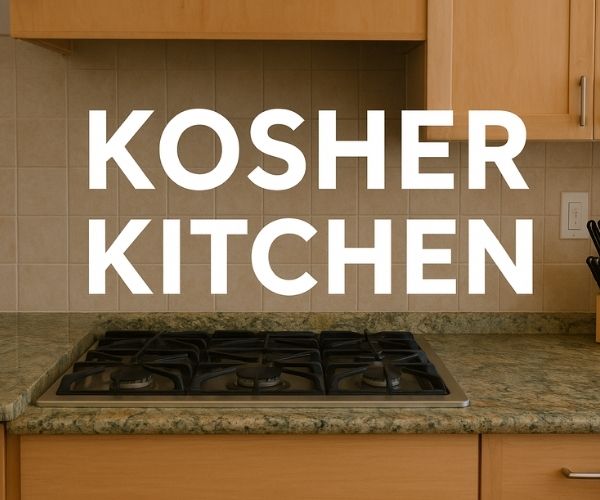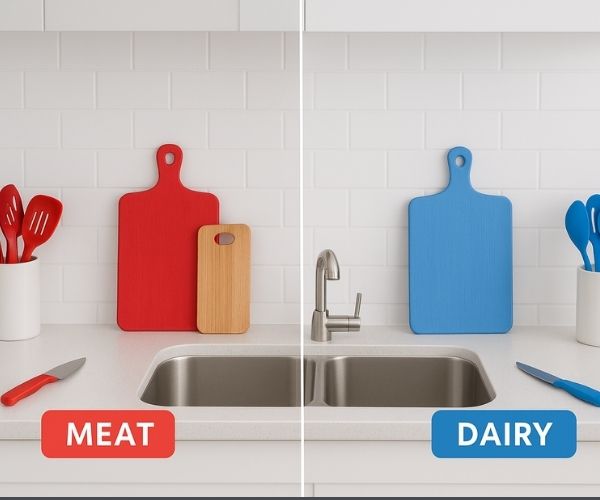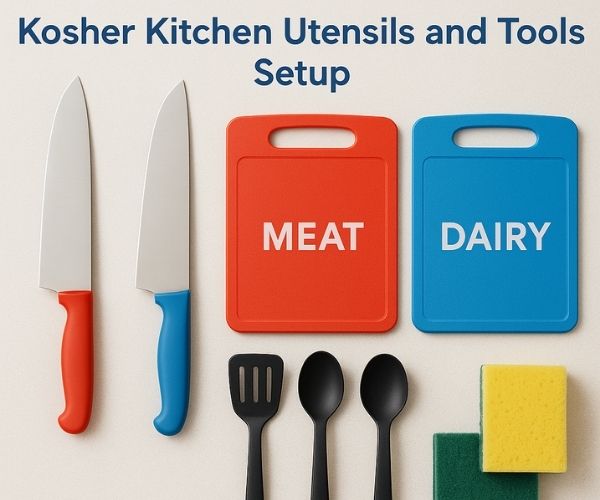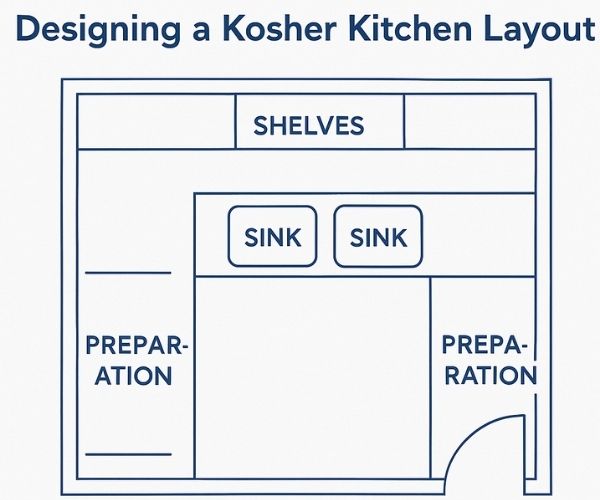Walk into any home that follows Jewish traditions, and you’ll probably hear the term kosher kitchen. At first, it may sound complicated but it’s actually about something simple – keeping food and cooking practices clean, respectful and meaningful.
A kosher kitchen isn’t only about faith, it’s a way of life. It’s about cooking with awareness, knowing what goes into your food, how it’s handled and how it connects to your values.

So, What Exactly Is a Kosher Kitchen?
A kosher kitchen is a cooking space designed to follow kashrut, the set of Jewish dietary laws that describe what foods are allowed, and how they must be prepared.
In short it’s a kitchen that:
- Keeps meat and dairy completely separate.
- Uses specific cookware for each food type.
- Avoids ingredients that are considered non-kosher (like pork and shellfish).
- Follows a clean and organized way of handling food.
From the refrigerator to the spoons, every item in the kitchen has a function and a location. It feels natural even peaceful, once you get used to it.
Separation and Respect
Separation is the cornerstone of any kosher kitchen, not as a limitation but as a gesture of deference.

Meat and dairy products should never be cooked, or consumed together according to Jewish law. Homes with kosher kitchens have two of everything including separate sinks, pots, pans and utensils to make that easier.
This might sound overwhelming at first but the majority of people follow a straightforward system. Some people color code or label everything for example, red for meat and blue for dairy. It becomes natural with time.
Kosher Kitchen Utensils and Tools

Utensils are like loyal partners each has its role and boundaries. Mixing them up can make food non-kosher, so people keep things organized and clear.
Setups include:
- One set of knives for meat, another for dairy.
- Different cutting boards, baking trays, and pans.
- Sponges and towels used only for their specific sections.
Many families also keep a small section for pareve neutral foods like fruits, veggies, or fish. These items can go with either side and are great for everyday meals.
It sound like a lot of work, but its actually one of the cleanest, most practical systems you’ll ever see in a kitchen.
What Is a Kosher Kitchen in Today World?

Traditionally kitchens were built out of necessity to follow religious laws. But in modern homes even among non-Jewish families people are adopting the concept for its organization, and hygiene.
A modern kosher kitchen can look just like any stylish kitchen in the U.S. It may feature quartz or granite countertops, stainless steel appliances, and smart storage but the structure behind it remains the same: order, separation and care.
SEE MORE: Best Trivets for Countertops
Bambu Pan Asian Kitchen Kosher
Its not just homes following kosher practices, restaurants like Bambu Pan Asian Kitchen Kosher show, how global flavors can still follow kosher principles.
They serve Asian inspired dishes like stir fried noodles, tofu bowls and kosher sushi all made with certified kosher ingredients. It’s proof that kosher doesn’t mean boring. You can respect dietary laws and still enjoy exciting, colorful and spicy food.
These modern eateries help people see that kosher can blend seamlessly, with contemporary dining.
Italo Pizza and Kosher Kitchen
Italo Pizza and Kosher Kitchen, which introduces kosher style into the pizza industry, are two more excellent examples.
They use kosher-certified ingredients to make everything including the dough and toppings. They use beef or plant-based pepperoni in place of pork pepperoni. The kitchen strictly separates dairy and non-dairy ingredients, and their cheese has a kosher certification.
It serves as a reminder that cuisine can be tasty, enjoyable, and traditional.
Designing Your Own Kosher Kitchen
You don’t need a lot of money or space to construct or renovate a kitchen that complies with kosher regulations. Good organization and a well-considered layout are what you need.

Here are some practical ideas:
- Two Sinks: One for dairy – one for meat.
- Separate Counters or Prep Areas: Portable divider can be used.
- Labeled Storage: Prevent misunderstanding on hectic cooking days.
- Durable Countertops: Quartz, granite or stainless steel are easy to clean.
- Two Ovens (if possible): Or at least use oven liners for different meals.
For smaller spaces, creativity matters more than size. Portable induction stoves or separate countertop appliances can help you keep things kosher even in tight apartments.
Kosher Kitchen and Clean Living
There’s something deeply refreshing about the kosher approach. It teaches you to cook with intention — to think before you mix, chop, or serve.
Many non-Jewish families in the U.S. now adopt some kosher kitchen habits because they promote hygiene and organization. Two separate food zones mean fewer chances of cross-contamination and cleaner storage practices.
In a world that’s always rushing, a kosher kitchen slows things down — not in a bad way, but in a mindful, meaningful way.
Kosher Kitchen Utensils for Beginners
Starting fresh? You don’t need to buy everything at once.
Here a simple checklist for a basic kosher setup:
- Two sets of utensils — one for meat, and one for dairy.
- Two cutting boards.
- Separate cookware.
- Labels, or color coding for easy identification.
- Kosher-certified dish soap and cleaning materials.
You can expand as you go. The goal is to make the space comfortable and easy to use while staying true to kosher values.
What Is a Kosher Kitchen Beyond Rules
It’s easy to think of kosher kitchens as rule-based but that’s not the full story. At its core, it’s about awareness a daily practice that connects people to gratitude, and discipline.
Cooking become more than just a task, it become a mindful act. The space feel calmer, cleaner, and more purposeful.
Adopting small components of the system, such as using separate cutting boards or organized storage, can balance your cooking routine even if you do not adhere to all kosher laws.





